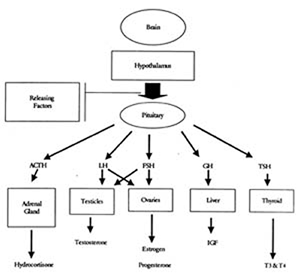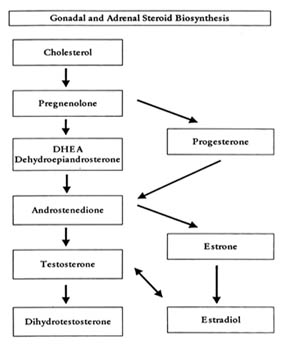Understanding Your Hormone System
Our hormone system is best understood if you think of it as a cascade (Figure 1), with the brain at the top followed by the pituitary gland, then target organs (i.e., ovaries, thyroid, testicles), and finally physical and mental functions (i.e., skin thickness, menstrual periods, sex characteristics, aggression, hair distribution, etc.).
Brain
The hypothalamus is the part of the brain where hormone release originates, starting off the cascade by secreting "releasing hormones" which turn on the pituitary.
Pituitary
The pituitary is known as our "master gland." It sits at the base of our brain and communicates directly with the hypothalamus by special nerves and blood vessels. Releasing hormones travel from the hypothalamus to the pituitary and stimulate the formation and release of pituitary hormones into our circulatory system. The pituitary hormones exert their effects on many of our organs, such as the thyroid, adrenal glands, testicles, ovaries, and breasts.
There are five basic pituitary hormones in which we are interested:
Human Growth Hormone (hGH)
Adrenocorticotropic Hormone (ACTH)
Thyroid Stimulating Hormone (TSH)
Follicle Stimulating Hormone (FSH)
Luteinizing Hormone (LH)
The pituitary hormones are released into the general circulation and have effects on specific target organs, which, in turn, release hormones of their own. Thus, the pituitary hormones act like air traffic controllers -- they survey the scene, determine what is needed, and then tell the organs in the body when to release their hormones.
Figure 1 shows an overview of some of the most important hormones.
Figure 1:

Human Growth Hormone (hGH)
Human Growth Hormone has more than one target organ but its primary target is the liver, where it causes the formation and release of insulin-like growth factor (IGF, a.k.a. Somatomedin C).
HGH has many metabolic effects, the most predominant of which is protein synthesis. HGH is released in bursts, most of which occur during certain stages of sleep. After we stop growing and become adults, there is a significant decrease in the amount of hGH we produce. IGF is a by-product of hGH, and is thought to be responsible for most of the anabolic (building) effects of the hormone itself. Fortunately, IGF levels are fairly constant in the blood and can be measured more easily than hGH. We, therefore, measure blood levels of IGF to assess the amount of circulating hGH in the body.
HGH is essential for bone and organ growth in our youth. Too little causes dwarfism; too much causes gigantism. It is very clear that hGH and IGF start to decrease sometime after age 15 - 20 and continue to do so quite rapidly. Although hGH is no longer needed for growth, per se, after reaching adulthood, hGH is essential for many other vital functions, and the significantly lowered levels seen as we age are thought to be correlated with everything from diminished energy to weight gain (fat) and decreased muscle mass.
In the past, if a pituitary gland was removed or destroyed due to a tumor in an adult hGH was not replaced, even though the more "essential" hormones, such as thyroid, hydrocortisone, and testosterone or estrogen/progesterone were replaced. It wasn't until the work of Dr. B. Bengtsson and Dr. Daniel Rudman that the value of Growth Hormone in adults was recognized. It was found that GH deficient patients had almost 50% higher rate of death from heart disease than expected (Figure 4). Dr. Bengtsson replaced Growth Hormone in pituitary deficient patients and achieved excellent results. In a 1990 New England Journal of Medicine article, Dr. Rudman reported on his pioneering experiments with the use of hGH in elderly veterans. He discovered that their body fat decreased and lean muscle mass, strength, skin thickness, and bone density increased. In other words, he was able to slow down the usual progression of aging by bringing patient's blood IGF levels up to those equivalent to a younger age group. In 1999, the National Institute on Aging completed another landmark study that was designed to either refute or substantiate the results of Dr. Rudman and also to extend his study by measuring other parameters. This was a double-blind, placebo-controlled, multi-center trial in both men and women with a large number of patients. This study involved not only hGH but gonadal (sex) steroids. This study not only confirmed the benefits of hGH that Dr. Rudman had asserted, but also demonstrated that the addition of gonadal steroids improved the effectiveness of Growth Hormone for both men and women. Although the NIA study showed that hGH alone did not increase muscle strength, it did substantially increase lean muscle and aerobic capacity. The addition of testosterone to hGH did, however, increase muscle strength substantially. (The findings of this study are available upon request.)
The Safety of Human Growth Hormone (hGH)
Taking Human Growth Hormone raises IGF-1 levels in the blood. It is the higher IGF-1 that mediates all the effects attributed to hGH. Most of the studies about the use of hGH in adults and children fail to show any risk of cancer related to the use of Growth Hormone or higher levels of IGF-1. In fact, in a review article published in the New England Journal of Medicine on October 14, 1999, authored by Mary Lee Vance, M.D. and Nellie Mauras, M.D., after an exhaustive literature search, concluded that "there is at present no evidence that Growth Hormone modulation affects the risk of cancer". All patients should be aware, however, that there are other reports that do indicate there may be a risk. In 1998, two published studies claimed a higher incidence of prostate cancer among men who had higher IGF-1 levels years before the onset of the cancer; but a number of experts agree that these studies are inconclusive and may be flawed. Problems cited with these studies include the method of statistical analysis, the several year interval between the drawing of the blood and the onset of cancer, and the absence of any IGF measurement at the time of diagnosis of the cancer. Several other studies show no difference in IGF-1 levels between normal healthy men and those with prostate cancer at the time of diagnosis and beyond.
Another recent study points to a higher incidence of breast cancer in pre-menopausal women (but not post-menopausal) who had higher IGF-1 levels one to five years prior to the onset of breast cancer. In this study, the blood was also drawn prior to diagnosis and was not analyzed for several years, making the conclusions reached somewhat suspect.
Although the majority of studies overwhelmingly point toward the safety of hGH, there is, as in virtually any area of medical science, some conflicting data among studies that confuses the issue. This is true because of the complex nature of the human body and its physiology -- and the truism that medicine is not an exact science. As in all aspects of medical therapeutics, each of us must evaluate the information that is available, along with our needs and desires and measure these against the potential risk, if any. Your Cenegenics® physician can help you understand and evaluate all the information available with as little prejudice as possible. Obviously we feel that for most patients the benefit of hGH therapy far outweighs the risk- otherwise we would not be pursuing this type of medical practice. Only you however, can make the decision for yourself.
To put it into context, similar controversy has surrounded the use of estrogen in post-menopausal women for the past 30 years. We now know that estrogen replacement in women may increase the risk of breast and endometrial cancer in some women with family histories of breast cancer, and other risk factors. However, because of estrogen's proven protective effects against many other diseases (Alzheimer's disease, heart disease, osteoporosis and colon cancer), overall mortality is lower in women who take estrogen than in those who do not. It will be many years before we have as much data on hGH as we do on estrogen, but we feel that for most people who have low IGF-1 levels, the benefits of taking hGH outweigh the risks.
Those studied and published benefits include:
· Increase in libido
· Decrease in body fat
· Increase in lean muscle
· Increase in bone density
· Increase in skin thickness
· Decrease in skin wrinkling
· Improved cholesterol profile
· Faster wound healing with lower infection rate
· Decrease in hospitalization rate by 50%
· Decrease in sick days from work
· Increase in exercise capacity
· Decrease in diastolic blood pressure
· Decrease in waist/hip ratio
· Increase in renal blood blow
· Increase in feeling of well being/improved socialization
· Strengthened immune system
Anecdotally claimed benefits include:
· Improved memory
· Improved cognitive function
· Hair re-growth
· Reduced spider veins
Just how much these benefits reduce mortality and whether or not they extend life span won't be determined for many years. What we do know is that the enhancement in the quality of our lives by the use of hGH is substantial.
Thyroid
Thyroid hormone greatly affects our metabolic rate and therefore our body temperature. Without out thyroid hormone, we cannot survive. Low thyroid levels cause decreased body temperature, increased cholesterol, and increased body fat. Often undetected in traditional medical practices, low thyroid levels can make it fiendishly difficult to lose weight. They can contribute to a subjective feeling of sluggishness and low energy as well as depression. As we age, our thyroid levels sometimes decrease and our body temperature and metabolism dip below normal. Supplementation of thyroid hormone is easy and inexpensive. The goal is to restore T3 and T4 to their natural ratio and blood concentrations.
Thymic Protein
The thymus gland shrinks with age; by 40 we may have only a small portion of our thymus still intact. It is considered highly likely that this is a contributory reason to age-related decreased immunity and increased risk of cancer.
Thymic Protein ATM (BioproTM) is useful for increasing immunity and resistance to cancer cells and infections. This protein programs T-4 "helper cells," to seek out invaders such as viruses, bacteria and cancer cells. The helper cells then send out T-8 "killer cells" to find the invaders and destroy them. Studies have shown that Thymic Protein ATM stimulates immunity and suppresses HIV. This is the same protein that is produced by the human thymus gland. It is classified as a nutritional supplement and taken orally. The maintenance dose is one packet per day under the tongue, and it is very effective.
Gonadal Steroids
These hormones are essential for normal reproductive function and the secondary sexual characteristics. They include testosterone, estrogen, and progesterone.
Adrenal Steroids
The adrenal glands release hydrocortisone (cortisol) and other hormones known as adrenal steroids. They are essential for life and are very important in our response to physical and emotional stress. In general, they do not decline with age, as do most of our other hormones.
All the adrenal and gonadal steroids are derived from the basic cholesterol molecule. Through several biosynthetic pathways, cholesterol is transformed into different steroid hormone molecules before it becomes estrogen, progesterone or testosterone.
Please keep in mind that when we take pregnenolone, DHEA (dehydroepiandrosterone) or androstenedione, we may influence the levels of their end products: testosterone, estrogen and progesterone. Therefore, it is important to monitor levels of both the administered hormone and its end products.
Figure 2 shows the progression from the cholesterol molecule to the gonadal and adrenal steroids.
Figure 2:
